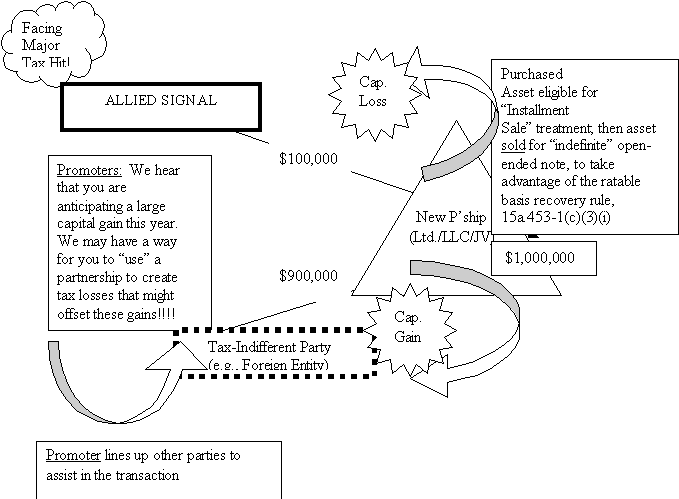Abusive Uses of Partnerships in Transactions
Substantially Similar to the Transactions at Issue in
ASA Investerings Partnership v. IRS ACM Partnership v. IRS

In these transactions, questions arise as to whether or not the parties have entered into a true partnership for federal tax law purposes (regardless of state law). Courts may conclude that the characteristics of the parties’ relationship are contrary to the characteristics of a bona fide partnership. The bona fides of any partnership can come into question when a taxpayer attempts to “use” a partnership structure so as to create a tax consequence aimed at mitigating an anticipated tax hit or creating a taxable transaction to offset expiring loss carryforwards.
In any partnership setting in which the bona fides of the partnership come into question, the courts will look at all of the facts and circumstances to determine whether the parties in a purported partnership (i.e., joint venture, LLP, LLC, LLLP) are, in fact, in a valid partnership, as opposed to a debtor-creditor or some other relationship. For example, when looking to see if a valid debtor-creditor relationship has been formed, the courts look to see if the investment in question, analyzed in terms of economic reality, constitutes risk capital entirely subject to the fortunes of the venture or represents a loan for which repayment was expected, regardless of the success of the venture. Again, labels are not binding on the courts or the IRS. The fact that all of the proverbial i’s have been dotted and the t’s crossed, or the fact that an entity has been properly organized in accordance with applicable state law will not stand in the way of a court finding some partnership to be invalid.
In the ACM Partnership case, 157 F.3d 231 (3rd Cir. 1998), Merrill Lynch is represented to have come up with a partnership structure for a Colgate-Palmolive Company, an international consumer products company. The company was faced with over $104,000,000 of long-term capital gains arising from the sale of a subsidiary in 1988, and Merrill Lynch approached the company with a proposed investment partnership that would generate capital losses that could be used to offset some of the 1988 capital gains.
In the ASA Investerings Partnership case, T.C.Memo 1998-305, the taxpayer, Allied Signal, was a manufacturing company that produced aerospace and automotive products. In early 1990, the company decided to sell an oil and gas interest and thereby, realize a capital gain of approximately $446,700,000. The company learned that Merrill Lynch had developed a tax proposal that could create capital losses to shelter the company’s anticipated capital gain. Merrill Lynch explained to the taxpayer that the proposal was a package deal by which they would serve as the partnership’s financial advisor and for a $7 million fee, recruit the foreign partner and arrange for the issuance and sale of the contingent installment gain notes. Merrill Lynch also proposed to serve as the partnership’s financial intermediary and handle all of the swap transactions. In the transaction, the company and its advisors spent a considerable amount of time ensuring that the tax indifferent foreign party partners received a specified return on their investment. The taxpayer wanted to ensure that its direct payments and partnership allocations to the foreign party were being properly credited toward the taxpayer’s obligation to make good on the specified return.
As in many of these transactions, the advisors to the taxpayer claimed that because there was no actual assurance, commitment, or binding agreement to pay a specified return to the tax-indifferent party who made the significant investment, a true partnership exists for federal tax law purposes. However, if the facts reveal that the taxpayer’s conduct resembles those of a meticulous borrower, rather than a partner, then the courts can be expected to look at the substance of the transaction and find that no true partnership exists for federal tax law purposes.
If you believe that you may have engaged in a transaction that is the same or substantially similar to the transaction described above, Federal law may require you to disclose your and other parties’ participation in any such “listed transaction” on IRS Form 8886. For more information about Federal law requirements, please contact us.
